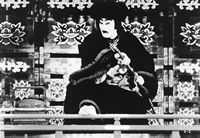
|
 |
Kabuki
Actor Nizaemon - The Chapter of Tosen
|
JAPAN
/ 1994 / Japanese / Color / 16mm / 158 min
Director: Haneda Sumiko
Photography: Nishio Kiyoshi, Soda Kikumatsu, Sato Kazuto
Sound: Takizawa Osamu
Producer: Kudo Mitsuru
Production Company, Source: Jiyu Kobo Co., Ltd.
15-1 Nanpeidai, Shibuya-ku, Tokyo 150-0036
Phone: 81-3-3463-7543 / Fax: 81-3-3496-4295

|
|
Haneda
Sumiko

Documentary filmmaker. Born 1926 in Dalian, North East China. Joined
Iwanami Productions in 1950. From 1953 worked as an assistant director
and wrote scripts for industrial films, then directed her first film
Women's College in the Village ("Mura no fujin gakkyu")
in 1957. In 1977, she produced independently the highly acclaimed
documentary The Cherry Tree with Gray Blossoms ("Usuzumi
no sakura"). She left Iwanami in 1981 in favor of independent
filmmaking. Her works include Ode to Mt. Hayachine ("Hayachine
no fu," 1982), and Akiko—Portrait of a Dancer
("Akiko—Aru dansa no shozo," 1985). She is especially
acclaimed for her work on the problems of old age such as seen in
How to Care for the Senile ("Chihosei rojin no sekai,"
1986), and the 6-part series Kabuki Actor Nizaemon ("Kabuki-yakusha
Kataoka Nizaemon," 1994), an intimate portrait of the late Nizaemon,
one of the greatest Kabuki actors of our time in the last years of
his life. In 1996 she made Welfare as Chosen by Our Town's Citizens
("Jumin no sentaku shita machi no fukushi"), and has just
completed work on its sequel, Questions Yet Remain ("Mondai
wa kore kara desu").  |
Kataoka Nizaemon the 13th (1903-1994) was one of the greatest Kabuki
actors of this century. Since making Nizaemon as Lord Sugawara
("Kan Sho-jo: Kataoka Nizaemon," 1982) featuring the great
actor performing his most celebrated role in the play The Tragedy
of Lord Sugawara ("Sugawara-Denju Tenarai-Kagami,")
it has been filmmaker Haneda Sumiko's life work to film the venerable
performer's old age. In 1994, she completed the monumental 6-part,
14-hour documentary Kabuki Actor Nizaemon ("Kabuki-Yakusha
Kataoka Nizaemon"). This film from that series is called Chapter
of Tosen. Tosen, taken from the words of a Sung-era poem is the
ascent towards the heavens of a hermit wizard. Haneda observes the
great actor's final days. He has been blind for years, and has gradually
lost control of his body and needs people to help him walk on stage.
Yet, when the music of the stage reaches his ears, the god of theater
possesses his body.
Juror's
Statement
Human beings are active creatures. We dream of unlimited progress,
unable to control ourselves. We somehow live surrounded by a flow
which forces us ahead. This flow only accelerates and we can do nothing
to suppress it. And so we are consumed with uneasiness. What fate
awaits the human race? Is unlimited progress truly possible? But happy
people are living creatures, and their lifetimes are limited. We are
greedy, yet incapable of learning anything about the world of death.
And so we direct all our energies towards living, and all, both the
good and the bad, is magnified and reproduced. What will become of
us? Full of riddles, human beings are also greedy when it comes to
self-pursuit. Such actions of self-expression give birth to art.
In a word, it is these reflections which inspire my thoughts. Cinema
exists as a fascinating means for me to express them.
Advances in technology allow anyone to lay hands on filmic images,
and make possible a myriad of expression. Such conditions give rise
to works which render difficult any classifications like fiction and
documentary. From the perspective of film art, a filmmaker's choice
of means of expression is quite broad and so it should be no surprise
that films are produced which do not fit into any category.
Most essentially, then, doesn't this mean that filmmakers can clearly
express their thoughts, whatever they may be, regardless of new technologies?
|
  |
|
before  next next
|
COPYRIGHT:Yamagata International Documentary Film Festival Organizing Committee |